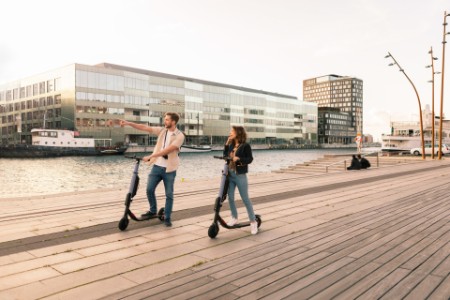The smart city concept has been an international trend in the technology sector and urban development for years. This is mainly due to the global development of cities.
By 2050, according to the UN World Population Report, about 70% of people are expected to live in metropolitan areas. Rapid population growth is accompanied by a shortage of space, a backlog in infrastructure and real estate investment as well as environmental effects (including air pollution). At the same time, municipalities have a duty to change the organisational and technological conditions, in order to continue to continue to fulfil their obligations.
What makes a city "smart"?
According to our definition a smart city is a city that meets its specific challenges with digital and cross-sector solutions. For the purposes of sustainable development, information and communication technologies are used to improve urban processes and services in terms of public service and sustainability.
New technologies are pioneers for such services. Converting previously analogue processes into digital processes using modern technology, however, does not do justice to the opportunities presented by digitisation. Rather, networking means enabling the exchange of data between previously separate systems. However, this networking at the data level always requires cooperation on an organisational, procedural, commercial, legal and technical level. The appropriate integration of technologies into the city structure is necessary for the development of a smart city. The smart city is built on five integrated levels: The built city structure (streets and buildings) acts as a basis and first level. This level is followed by an infrastructure network with technical facilities and equipment. The third level collects and combines data. The fourth level includes IT platforms that process third-party data and prepare it for applications. At the last level, the resulting service offers are put in place for the users.
The key to many innovative solutions rests in particular on cross-sector data platforms and IoT networks, customer-oriented and transparent administrative processes, as well as additional services provided by municipal companies and new partnerships between local actors and business.
Smart city applications as a remedy against urban air pollution
Nitrogen oxide pollution in cities is increasing. In 2015, 151 European cities exceeded the limit of 40 mg NO2/m3. The consequences are an increase in particulate matter with a heavy health burden for citizens. Cities face the concrete challenge of optimising traffic flows while reducing environmental impact.
Parking plays an important role in the development of traffic, as cars are parked on average 23 hours per day. According to the Quantum 2020 study, people looking for parking account for up to 30% of total urban traffic. Today's parking management has considerable potential for optimisation. So-called "smart parking" applications can reduce the effects of parking-search traffic through sensor-based parking guidance systems by up to 30% and reduce maintenance costs and outlays. In "smart parking", sensors (ground or overhead) collect parking space data in real time and forward it to a cloud-based data exchange platform. An application on the driver's smart phone retrieves the data from the platform and navigates to a free parking space. With the help of such applications, not only can NO2 and CO2 emissions be reduced, but higher parking revenues can also be generated by a demand-oriented fee model. As part of a smart city strategy, the parking application thus combines both sustainability goals and economic goals.
Global Trends
In a global comparison, there are very contradictory approaches to the implementation of smart city concepts. Due to different challenges, such as rapid population growth, it is primarily cities in Asia that have to react quickly and efficiently to changing conditions.
"Virtual Singapore" is the example of a city that needs to respond to its strong growth in the shortest possible time. The city state has about 5 million inhabitants. Measuring digital data with the help of sensors and cameras, the "Virtual Singapore" project summarises the movements of city dwellers and evaluates them for further development scenarios. This project is the world's largest data collection for a city. At present, it is not yet clearly defined which service offers should be generated from this for city residents. In addition, social aspects in the private sphere, such as care of elderly people living alone, are taken into account by monitoring with the help of sensors, as well as more efficient organisation of public administration structure.
Each city is individual and, for this reason, must be considered individually in the transformation towards a smart city. Especially in European cities, a top-down approach will not work. Transparent public participation and new forms of cooperation between city administrations and companies are crucial for the further development of a city.


